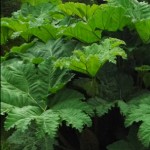 Although flowers catch the eye, leaves play a very important role in the garden. Most perennials are only in bloom for a short time and when the flowers are gone the leaves have to carry the show. In most parts of the US the garden has no flowers from late fall until early spring and foliage increases in importance. Even when flowers are in full bloom leaves can add texture, form and color that can increase the impact of the flowers. Although we take the color green for granted and hardly notice it, there are many different shades of green, and many leaves that are variegated, purple, red, yellow, or silver. Choosing plants with foliage that will enhance the garden is an important aspect of garden design and involves practical as well as aesthetic considerations.
Although flowers catch the eye, leaves play a very important role in the garden. Most perennials are only in bloom for a short time and when the flowers are gone the leaves have to carry the show. In most parts of the US the garden has no flowers from late fall until early spring and foliage increases in importance. Even when flowers are in full bloom leaves can add texture, form and color that can increase the impact of the flowers. Although we take the color green for granted and hardly notice it, there are many different shades of green, and many leaves that are variegated, purple, red, yellow, or silver. Choosing plants with foliage that will enhance the garden is an important aspect of garden design and involves practical as well as aesthetic considerations.
There are several practical considerations that should be employed when a plant is selected for the garden. The first is, will it grown in the site? This should be the first consideration when choosing any plant but is equally important when selecting a plant for its foliage. A second consideration concerns the resistance of the leaves to disease, pests, sunlight, and drought. Leaves that have given way to slugs or mildew, or have been sunburned, or are edged with brown from droughty conditions are not attractive in the garden. Thirdly, the leaves should be attractive for a long time. Daffodil leaves are so unattractive as they turn brown most people cut them off or tie them up even though this is not in the best interest of the plants. The foliage of European ginger, on the other hand, is evergreen, while that of fothergill is stunning in the fall so including such plants will enhance the garden at a time when little else is attractive.
Aesthetic considerations are effected by personal preferences and are more difficult to define but they primarily are concerned with the size, shape, texture, and color of the leaves. The size of leaves varies tremendously from the large leaves of gunnera (Gunnera manicata) to the small leaves of Japanese holly (Ilex crenata). The size of the leaves will in turn have an effect on scale with some leaves being more pleasing in a given situation than other. Leaves also vary in their shape; some are shaped like lances, other like hearts, spades, or hands. The margins of leaves vary as do their arrangement on the stem and the degree of shine or dullness on their surface. All of these variations affect the textural qualities that the leaves add to the garden and must be taken into consideration when choosing plants.
But what about color? Leaves come in many shades of green; pea green, dark green, olive, and still others with hints of blue or gold. They also may be red, purple, yellow, gray, silver or a combination. Silver and gray foliage have a cooling effect and are especially beautiful in the evening. Yellow foliage can brighten a shady corner as well as add color in its own right. Red and purple foliage often fade in the course of the growing season so enjoy them while they are in their prime and plan for the time they are not. Leaves with color in part of the leaf are considered variegated. The non green portions of the leaves may be in stripes, blotches, on the margins and can be red, pink, white, cream, or yellow. Variegated plants are best used in moderation usually in contrast to solid green ones or to create an echo of the flowers of other plants that are the same color as the variegation.
Leaf color is best considered secondary to practical considerations as well as other aesthetic ones. After determining the plants that are most suitable for the site, consider the size, shape, and texture to create an rich design by contrasting and repeating the various elements. Add color to make a harmonious whole with perennials and annuals for a spectacular garden with interest all year long.